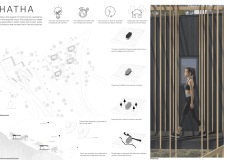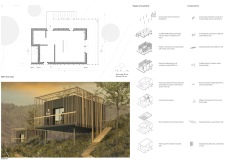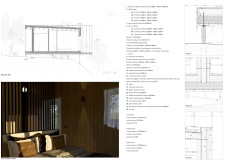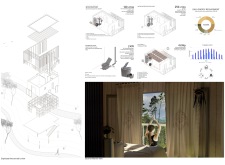5 key facts about this project
The structure emphasizes natural elements, utilizing a material palette that includes XLAM panels, cork insulation, wood slats for cladding, and photovoltaic panels. These elements collectively facilitate energy self-sufficiency and enhance thermal performance. The project incorporates innovative design strategies such as elevated frameworks that minimize site disturbance and maximize interaction with the natural environment.
Sustainable Architecture: Key Features and Approaches
Hatha distinguishes itself through its distinctive architectural approach that prioritizes sustainability and user experience. The incorporation of renewable energy sources such as solar panels exemplifies the project's commitment to self-sufficiency. Additionally, rainwater harvesting systems effectively manage water resources, contributing to the overall sustainability ethos. The design prioritizes natural light through strategically placed openings, reducing reliance on artificial lighting and enhancing indoor environmental quality.
The modular arrangement of the pods supports diverse residential configurations while maintaining a cohesive aesthetic. Each pod is oriented to take advantage of prevailing winds and sunlight, optimizing heating and cooling. By embedding structures within the landscape, Hatha reflects a unique harmony between the built environment and its natural setting.
Innovative Design Elements and Materials
Each component of the Hatha project has been meticulously selected to support both functionality and aesthetics. The use of maritime pine for external cladding not only provides durability but also integrates seamlessly with the natural surroundings.
The architectural design incorporates OSB panels for structural strength while optimizing material efficiency. The elevated design minimizes the footprint on the landscape and encourages airflow, further contributing to climate-responsive solutions. Furthermore, the careful detailing of circulation paths fosters connections between pods and communal areas, enhancing social interaction across the site.
Attention to detail extends to interior designs, where decorative wooden slats provide warmth while ensuring privacy. Collectively, these design choices highlight a commitment to innovative thinking in architecture, underscoring the importance of creating spaces that respect and respond to their environment.
For an in-depth appreciation of the project, including architectural plans, architectural sections, and further architectural designs, interested readers are encouraged to explore the comprehensive presentation of Hatha. This exploration will offer a deeper insight into the project’s innovative architectural ideas and its role in the future of sustainable design.


























